
Airport Facts
Suvarnabhumi Airport covers an area of some 20,000 rais (8,000 acres). The new international airport is located about 15 km of on the east-bound Bangna-Trat Highway in Bang Phli District, Samut Prakarn Province and is about 25 km from downtown Bangkok.

There are many more facilities at Suvarnabhumi Airport compared to the current Bangkok International Airport to the facilities and better service provision for passengers.
- 130 passport control checkpoints for arrivals, 72 for departures.
- 26 customs control checkpoints for arrivals, 8 for departures.
- 22 baggage conveyor belts.
- 360 check-in counters. There are 100 additional counters for passengers with no luggage to check-in to minimize queuing time.
- 107 moving walkways.
- 102 elevators.
- 83 escalators.
- 18 slanted moving sideways.

Runways open for operation in the initial phase are the eastern runway with the length of 3,700 meters and width of 60 meters.
Accommodation capacity: at the initial phase of service provision, the north section of the airport will be able to accommodate 45 million passengers per year, 76 flights per hour and 3 million tons of cargo handling per year.
Characteristics: asphaltic concrete
Taxiways: 52 taxiways are to be in operational service.
Aircraft parking space: 120, of which 8 are for Airbus A380 (5 of them are contact gates)
The control tower is 132.2 meters high. It is the world’s tallest control tower, fully-equipped with the best technologies that will facilitate smooth air traffic control. It has the ability to manage approximately 76 flights per hour.
Car parking buildings: located at the front of the passenger terminal complex. There are 2 car park buildings with a capacity of approximately 5,000 cars. In addition, there are parking areas on the ground level on the exterior which can accommodate approximately 1,100 cars. There is also a long term parking area that can accommodate approximately 4,000 cars and 78 buses.
The airport operation building is a 6 storey building which consists of AOT administrative office, airline offices and governmental offices, with a canteen on 1st floor.
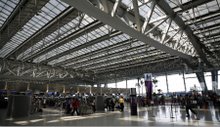
Airport information management system
The management of Suvarnabhumi Airport uses a comprehensive hi-tech system, which employs the Airport Information Management System (AIMS) to support and coordinate all interconnected systems in the various buildings of the airport. AIMS will facilitate the smooth operation of the baggage sorting conveyor belts, the loudspeaker system, the aircraft parking control system, commercial activities management and the free zone management that will assist the air freight activities. In addition, AIMS is also connected to 4 computer systems outside the terminal complex:
- Aeronautical Information is connected to the systems of the Aeronautical Radio of Thailand Co., Ltd, airline offices, immigration offices, the custom department, the Department of Civil Aviation and other relevant offices.
- Commercial Activities Information. AIMS’ ‘Point of Sales’ module handles commercial activities inside the airport. Businesses who operate at the airport have to submit their financial materials to AIM.
- Security Information. AIMS is fed with picture and information output from the access control system which links the closed circuit television and other security systems together.
- Maintenance and Equipment Information. There is a support and maintenance system to aid the work of all the other systems.
AIM is therefore the core of the control system of Suvarnabhumi Airport.
The airport information management system building is a 6 storey building with 4 main technical centers: Airport Operation Center (AOC), Security Control Center (SCC), Crisis Control Center (CCC) and Network Management Center (NMC).
- 1 st floor is for the installation of the Foundation structures such as the power distribution system, the security system, fire extinguishing system and the computer and the electronic network systems.
- 2 nd floor consists of the Crisis Control Center (CCC) and seminar rooms.
- 3 rd floor consists of the Airport Operation Center (AOC) and the security Control Center (SCC).
- 4 th floor is used as administrative offices.
- 5 th floor is for the Network Management Center (NMC) and the Benchmark Test Laboratory.
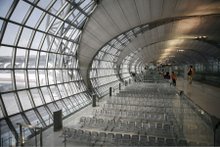
Cargo
The “Free Zone” arranged by AOT is a new system of handling cargo at the Suvarnabhumi Airport, “Customs Free Zone”. This new system is aimed at enhancing the efficiency of cargo management at Suvarnabhumi Airport. A state-of-the-art technology is employed to facilitate the new system. Businesses utilizing the free zone will enjoy a smooth and efficient business environment with less paperwork.
The Free Zone area is located in the Northeastern part of the airport possessing the ground area of 549,416 square meters or approximately 345 rai with further 111,156 square meters of ground for public use. The main buildings include:
- Cargo handling building of Thai Airways International PLC and WFSPG Cargo Co., Ltd.
- Buildings for cargo facilities
- Buildings for Freight Forwarders
- Buildings for customs offices and related governmental offices
- Buildings for the administrative offices of Free Zone
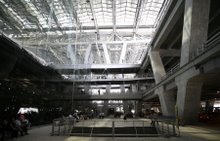
Suvarnabhumi passenger terminal complex comprises of 7 stories above ground and 2 stories below ground. Facilities for both domestic and terminal passengers are situated in the same building.
- 1 st floor is the bus lobby. Buses are not allowed to go to 2nd and 3rd floors in order to avoid the traffic congestion. Additionally, there is a medical center, an AOT office for electricity monitoring and airport control offices.
- 2 nd floor is the arrival hall for both domestic and international passengers.
- 3 rd floor consists of airline passenger waiting lounges, shops, security checkpoints, meeting points, service counters and CIP lounges.
- 4 th floor is the departures hall. This hall features facilities for both international and domestic passengers, lounges for premium passengers, Thai Airways International PLC, customs control checkpoints, some governmental offices, airline booths, airport information counters and escalators in the centre which can take passengers right up to restaurants on 6th floor.
- 5 th floor is the offices for Thai Airways International PLC and Star Alliance airlines.
- 6 th floor consists of restaurants, which can be accessed via the escalators from 4th floor.
- 7 th floor serves as observation area.
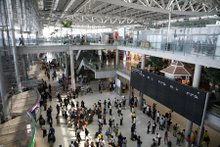
The lower ground floors are termed floors 0 which serves as the train station, and floor -1 for train platforms. The lower ground floors also house the baggage conveyor systems.
The 7 concourse buildings (from A to G) are connected to the passenger terminal. The combined area of the concourse buildings and the passenger terminal stretches over 563,000 square meters, whereas the area of the current Bangkok International Airport (Terminals 1&2) totals 321,166 square meters. The concourse buildings are made of glass and a special synthetic material which is very tough and durable coated with Teflon that prevents the accumulation of dirt and grime. Passengers can walk to the concourse buildings from the terminal complex via the concourse building D, which is directly connected to the terminal complex.
The concourse buildings A and B are for domestic passengers. Details are as follows:
- Concourse building A is for domestic passengers, and is approximately 432 meters long. This building can accommodate 6 aircraft and has 1 connection channel that allows access to the remote parking bays.
- Concourse building B is for domestic passengers, with the length of approximately 270 meters. This building can accommodate 6 aircraft and has 2 connection channels that allow access to the remote parking bays.
The concourse buildings C, D, E, F and G are for international passengers. Details are as follows:
- Concourse building C is approximately 459 meters long and can accommodate 10 aircraft with 2 connection channels to access the remote parking bays.
- Concourse building D has the length of approximately 909 meters, and can accommodate 8 aircraft with 2 connection channels to access the remote parking bays.
- Concourse building E is approximately 459 meters long and can accommodate 10 aircraft with 2 connection channels to access the remote parking bays.
- Concourse building F is approximately 270 meters long and can accommodate 6 aircraft with 2 connection channels to access the remote parking bays.
- Concourse building G is approximately 432 meters long and can accommodate 5 aircraft with 1 connection channel to access the remote parking bays. The VIP lounge is also located here.
The intersections of the concourse building are called the airside center. There are 2 intersections on the 3rd and 4th floors which will be used for shops; the exterior of the concourse building will be developed into airline offices and airline lounges.
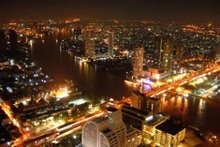
Information on Bangkok
Sight-seeing in Bangkok : If your stay in Bangkok is a short one, you won't be able to see all the attractions. For visits of four to five days, include Wat Phra Kaew and the Grand Palace along with Wat Po, Wat Arun, the National Museum, Erawan Shrine, Vimanmek Teak Mansion and a river or canal trip.
If you have longer, say 10 days or more, include a trip to Jatuchak Weekend Market (where you can buy just about anything). Evenings are a good time to sample the diverse Bangkok cuisine, especially at some Thai restaurants where you can also enjoy cultural performances or riverside restaurants where you can feel the atmosphere of the old city.
